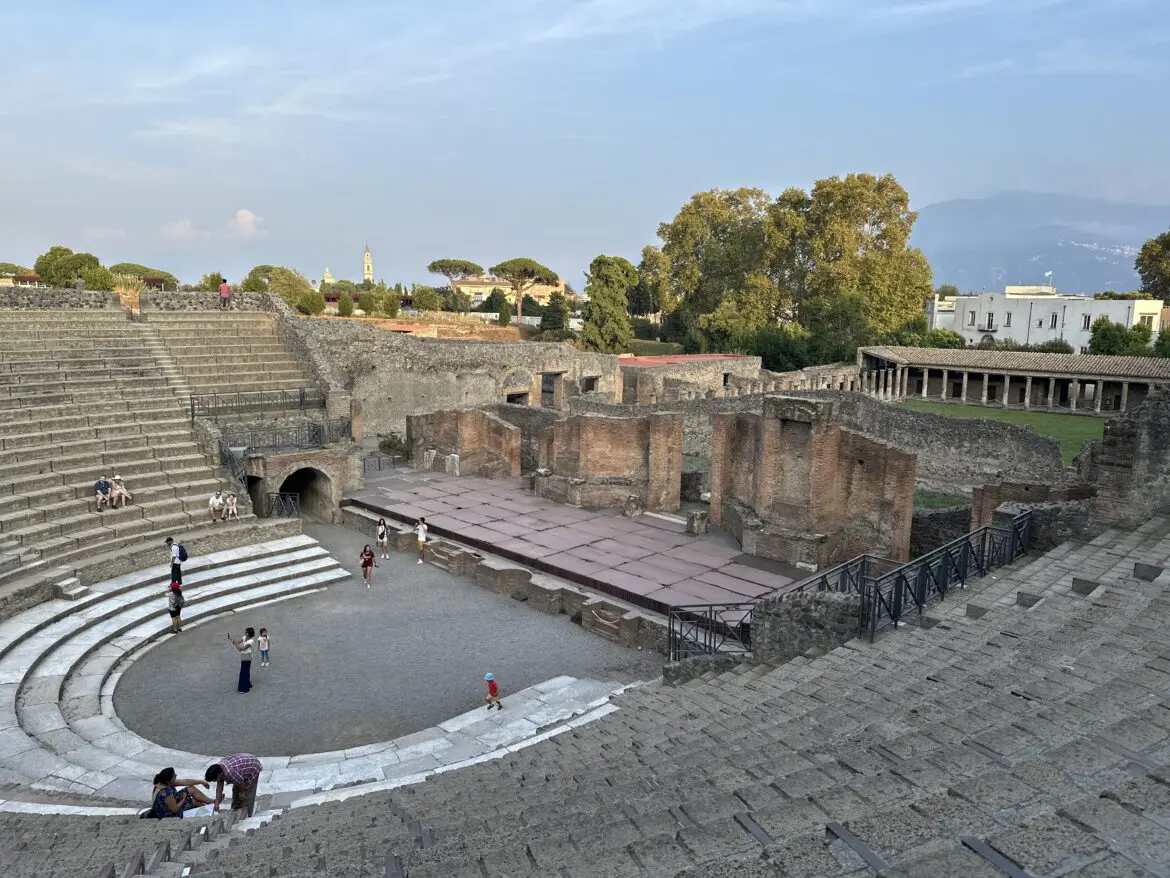On a recent visit to Italy, we rented a car and ventured out from Rome to check off a few of our bucket list places to visit.
We drove to Tivoli and had a tasty lunch at Il Cavallino Rosso overlooking the Villa Gregoriana, a beautiful garden that was built by Pope Gregory XVI in 1832. Then we decided to head south to Naples and the Amalfi Coast. While these places are gorgeous, I had my heart set on visiting the ancient ruins of Pompeii.
Listen to Unscaled Travel Show Ep. 65: Exploring Pompeii: Highlights, Tips, and Nearby Treasures
Historical Context and Significance
Pompeii was once a thriving Roman city with a population of close to 15,000 inhabitants. It is thought to have been a city based on wealth and influence. A playground for the aristocrats and influencers of their day.
That all changed in 79 AD when nearby Mount Vesuvius violently erupted and, over the course of two days, buried the city under nearly 20 feet of volcanic ash and pumice rain. The town became frozen in time, and the poor souls that were caught in the eruption were entombed, untouched for centuries.
In those centuries the town was basically “lost” as the world moved on. The buried city was “rediscovered” a number of times on a small scale, but was formally reintroduced to the world in the 18th century. Since then, ongoing excavations that carry on today have unearthed significant findings that provide incredible insights into Roman civilization, art, literature, and historical understanding.
Must-See Sites in Pompeii
A visit to Pompeii is like stepping back in time. There are too many interesting villas, shops, and residences to make a complete list in this section, but if you have a short amount of time in Pompeii, there are a few spots you shouldn’t miss. Here are some of the must-see sites within the archaeological zone:
The Forum
At the heart of Pompeii’s everyday life, the Forum is surrounded by essential civic buildings and temples. This central square was the hub of political, religious, and social activities including trade and markets. There are several buildings of note located around the Forum including the Temple of Jupiter, the Basilica, and the Macellum. Each building gives a small glimpse into urban planning and Roman architecture.
As you enter the Forum area, you’ll also see the famed centaur statue. Despite its ancient look, it’s actually a modern piece by Polish sculptor Igor Mitoraj.
Teatro Grande (The Great Theatre of Pompeii)
This beautiful theatre is one of the oldest and best preserved Roman amphitheaters in the world, and it offers a fascinating look into ancient entertainment. In the days of ancient Pompeii, this is where up to 5,000 spectators sat to watch the latest theatrical works, music, and dance performances.

The House of the Faun
The House of the Faun is one of the more popular stops in Pompeii. It is one of Pompeii’s largest and most opulent residences and is renowned for its intricate mosaics, including the enormous floor mosaic of Alexander the Great battling King Darius at the Battle of Issus.
The atrium of the home was decorated with a beautiful mosaic floor and in the center was a bronze statue of a dancing satyr, which was interpreted as a faun, hence the name.
Villa dei Misteri (The Villa of the Mysteries)
Located on the outskirts of Pompeii, this villa is celebrated for its large, well-preserved frescoes that illustrate enigmatic initiation rites, offering a glimpse into the private lives and beliefs of its ancient inhabitants. It’s a beautiful and thought-provoking place to visit while you’re in Pompeii.
Practical Travel Tips for Visiting Pompeii
To make the most of your visit to Pompeii, consider these practical tips:
When to Visit Pompeii
The best times to visit are during the spring and fall to avoid the extreme heat of summer and the crowds. Early morning or late afternoon visits are ideal for cooler temperatures and fewer tourists. We visited Pompeii in early October and it was a warm day. The lack of shade in the archaeological zone can also play a significant factor in your visit.
Guided vs Self-Guided Tours
Hiring a guide can enrich your experience with detailed historical insights, while self-guided tours allow for more flexibility. Reputable tour companies and comprehensive guidebooks can enhance either option but always be wary of scams online. Try your best to book through a reputable company such as Viator.
Another note is to book your tour as early as possible. In peak travel months these tours can sell out quickly, leaving you and your group to fend for yourselves.
We decided to walk around ourselves since we arrived so late in the afternoon, but we had a good time. They do give you a map and, if you ask the staff, they’ll gladly point out the highlights to you if you don’t have much time to dedicate to walking the entire city.
When we return to Pompeii, we’ll definitely do our best to secure a guided tour because their tour guides have tons of great information that adds value to your time in Pompeii.
What to Bring and What to Leave
Pack comfortable shoes, plenty of water in a refillable bottle, sun protection such as a hat or umbrella, and a map or guidebook. Again, an official map is given to you at the entrance but a guidebook in your native language wouldn’t hurt at all.
Remember, the site is vast, and you’ll be doing a lot of walking.
One thing they don’t allow in Pompeii is large bags. Large bags and luggage items will have to be checked at the front gates. You can store them in an on-site locker for safe keeping while you explore, but they won’t permit them inside the archaeological zone.
Accessibility
While some areas may be challenging for visitors with mobility issues, many parts of Pompeii are wheelchair accessible. Plan your route accordingly and check for accessible paths and entrances.
Beyond Pompeii – Exploring the Region
Pompeii is just one highlight of the region. On our trip we had rented a car so our journey was a bit more flexible, but public transportation in Italy is pretty reliable and gets you to most of the places you’ll want to go. Here are some additional places to consider in the area:
Herculaneum
Named for the ancient mythical hero Hercules and often overshadowed by Pompeii, Herculaneum offers a different perspective on the eruption’s impact. It’s smaller but somewhat better preserved, with some wooden structures and materials intact.
Mount Vesuvius
For the adventurous, hiking to the summit of Vesuvius awards travelers with stunning views and a chance to peer into the volcano’s crater. Guided tours are available, detailing the geology and history of the infamous eruption. You’ll gain a brand new perspective on the power and devastation of the events that buried the area in 79 A.D.
Naples and Pompei
Sitting right next door to ancient Pompeii, Naples boasts attractions such as the Naples National Archaeological Museum, which houses many artifacts from Pompeii. Travelers can enjoy the city’s markets, historic sites, and delicious cuisine. The city also has a number of travel options, such as trains and buses, that will take you to and from the ruins if you decide to stay in the area.
Pompei, the modern city, is also next to the ruins of Pompeii. It can be a bit confusing at first but the modern city is spelled with one ‘i’ and the ruins have two. The modern city is quiet and slower-paced than its ancient counterpart but you can still find great local shops and eateries.
Amalfi Coast Region
We originally bypassed Pompeii and drove through the mountains to Amalfi. Yes, it’s a gorgeous stop, but it’s extremely popular so expect crowds almost year round. Parking is a premium, so if you rent a car like we did, be prepared to search for a parking spot. Be patient, because the roads will fill up with cars, Vespas, and tour buses.
Our stops on the coast included the picturesque towns of Positano, Pianillo, and Ravello. People rave about nearby Salerno as well. We also had one of the best meals we’ve ever eaten at Calajanara Restaurant in Conca dei Marini. It was so gorgeous that I still think about it all the time.

A visit to Pompeii is a journey through time, offering an intimate look at ancient Roman life and the catastrophic event that preserved it for centuries. By exploring the ruins, understanding their historical context, and venturing beyond to nearby attractions, you’ll gain a deeper appreciation for this remarkable site. Whether you’re a history enthusiast, an adventure seeker, or a curious traveler, Pompeii and its surroundings promise an unforgettable experience.

